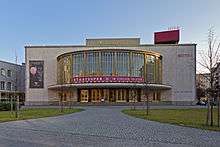Schiller Theater


The Schiller Theater is a theatre in Berlin, Germany.
During the 1920s and 1930s, it was used by the Preußisches Staatstheater Berlin theatre company and, after post-war rebuilding, from 1951 to 1993 the Staatliche Schauspielbühnen Berlin. In 1993, the Berlin Senate decided to close it for financial reasons. It is now rented out for theatre performances and other events, and is used by the Staatsoper Unter den Linden as a second venue.
It is located in the district of Charlottenburg of the borough of Charlottenburg-Wilmersdorf near Ernst-Reuter-Platz in Bismarckstraße 110 (formerly No. 117-120).
History

The Schiller Theater was built from 1905 to 1906 according to plans by the Munich theatre architect Max Littmann for the Schiller-Theater AG and the town of Charlottenburg.
The sculptural decoration was designed by the sculptors Düll and Petzold, and the decoration of the auditorium and the painted curtain is from Julius Mössel.
Professor Raphael Löwenfeld was the initiator and founding manager. The 1,194-seat theatre was opened on 1 January 1907 with Die Räuber by Friedrich Schiller, and continued to be run by the Schiller-Theater-Gesellschaft with their own theatre company.
In the 1920s and 1930s, the building was the second venue of the Preußisches Staatstheater Berlin, whose main venue was the Schauspielhaus am Gendarmenmarkt.
From 1937 to 1938, the theatre was extensively rebuilt for the city of Berlin by Paul Baumgarten. Baumgarten simplified the facade and the auditorium considerably, changing the appearance of the theatre with respect to the New Objectivity of the 1920s, but also in line with the prevailing monumental architectural trend of National Socialism. A government box was incorporated. The sculptors Paul Scheurich and Karl Nocke and the painter Albert Birkle were involved in the conversion.
From the re-opening with Schiller's Kabale und Liebe in 1938 the theatre was run as the Schiller-Theater der Reichshauptstadt Berlin. The actor Heinrich George was the manager, under the pseudonym of Heinrich Schmitz.
The theatre was destroyed in an air strike on 23 November 1943. From 1950 to 1951, it was rebuilt for the city of Berlin according to plans by the architects Heinz Völker and Rolf Grosse.

Some parts of the ruins of the old theatre were re-used for the new construction. At the re-opening on 6 September 1951, Schiller's Wilhelm Tell was performed.
The new Schiller Theater had 1,067 seats, and was, as the Großes Haus, the main venue for the Staatlichen Schauspielbühnen Berlin, which used the Schlossparktheater in Steglitz as the Kleines Haus, its second venue. It also used the Schiller-Theater Werkstatt in the building of the Schiller Theater (now a secondary venue of the GRIPS-Theater), and the Ballhaus Rixdorf as further venues. Among the famous managers were Heinrich George, Boleslaw Barlog, Hans Lietzau, Boy Gobert and Heribert Sasse[1]
Notable directors included Gustaf Gründgens, Jürgen Fehling, Samuel Beckett, Fritz Kortner, Boleslaw Barlog, Hans Lietzau, Karl Paryla,[2] George Tabori, Hans Neuenfels, Hans Hollmann and Peter Zadek.

In 1993, the Schiller Theater was closed on a decision of the Senate of Berlin because of the financial difficulties of Berlin, and all permanently employed staff and artists (including Bernhard Minetti, Erich Schellow and Sabine Sinjen) were dismissed. The closure of the largest German-speaking stage sparked protest and resentment, and the Senator for Culture at that time, Ulrich Roloff-Momin, was given the name "Schiller-Killer".[3] It was then used as a venue for musicals and guest theatre performances.
From January to October 2000, the Maxim-Gorki-Theater used the stage of the Schiller Theater.
The last performance of the state theatre there was the premiere of the play Weißalles und Dickedumm by Coline Serreau with Katharina Thalbach.
Replacement venue for the Staatsoper
When the Staatsoper Unter den Linden had to close on May 31, 2010 for renovation, the company and the Staatskapelle Berlin were accommodated in the Schiller Theater. The reconstruction work began in June 2010 and is expected to cost 239 million euros. The Staatsoper is expected to stay at the Schiller Theater for three years.[4]
The first opera premiere in the temporary venue took place on 3 October 2010.[4][5][6]
Actors
The actors who have appeared in leading roles in the Schiller Theater include the following:
|
|
|
Notable premieres
- Samuel Beckett: Warten auf Godot (1953, Regie: Samuel Beckett)
- Max Frisch: Don Juan oder Die Liebe zur Geometrie (5. Mai 1953, simultaneously with the Schauspielhaus Zürich)
- Martin Walser: Eiche und Angora (23. September 1962)
- Peter Weiss: Die Verfolgung und Ermordung Jean Paul Marats (29. April 1964)
- Günter Grass: Die Plebejer proben den Aufstand (15. Januar 1966)
- Günter Grass: Davor (14. Februar 1969)
- Conor Cruise O'Brien: Mörderische Engel (10. Januar 1971)[2]
- Thomas Bernhard: Einfach kompliziert (28. Februar 1986)
- Pavel Kohout: Patt (29. August 1987)
- Thomas Bernhard: Elisabeth II (5. November 1989)
- Volker Braun: Böhmen am Meer (11. März 1992)[7][8]
- Edward Albee: "The Zoo Story" (1959)
References
- ↑ (…) Gobert-Nachfolger als Schauspielbühnen-Leiter. In; oe1.orf.at, 18 February 2004, accessed on 26 November 2010.
- 1 2 Im Berliner Schillertheater wird heute (…) In: Arbeiter-Zeitung, 10 January 1971, p. 4, picture comment.
- ↑ Rockwell, John (29 June 1993). "Germans Protest Planned Closing Of the Schiller Theater in Berlin". Arts. The New York Times. Retrieved 29 April 2011.
- 1 2 Apthorp, Shirley (4 October 2010). "Dead Director Doesn't Help Opening of Berlin's Schiller Theater". Anywhere. Bloomberg. Retrieved 29 April 2011.
- ↑ "Staatsoper im Schiller Theater". Oper in Berlin. Stiftung Oper in Berlin. Retrieved 29 April 2011.
- ↑ "Schiller Theater". Staatsoper im Schiller Theater. Staatsoper Berlin. Retrieved 29 April 2011.
- ↑ Die ganze beschissene Welt auf dem Buckel. In: Neues Deutschland, 12 October 2010.
- ↑ As the Schiller Theater in Berlin is an opera
External links
| Wikimedia Commons has media related to Schillertheater. |
- Berlin Schiller-Theater (old)
- Berlin Schiller-Theater (new)
- Schiller Theater in the Lexikon: Charlottenburg-Wilmersdorf von A bis Z
52°30′42.1530″N 13°19′5.01″E / 52.511709167°N 13.3180583°ECoordinates: 52°30′42.1530″N 13°19′5.01″E / 52.511709167°N 13.3180583°E